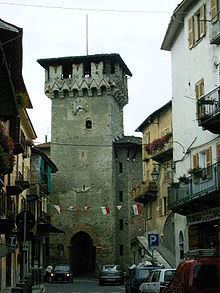Elevation 525 m (1,722 ft) Time zone CET (UTC+1) Postal code 10074 Dialling code 0123 | Demonym(s) Lanzesi Area 10.4 km² Local time Sunday 6:28 PM | |
 | ||
Frazioni Oviglia, Fua, Ovairo, Brecco, Momello, Praile, Margaula, Colombaro, Grange Weather 11°C, Wind N at 6 km/h, 46% Humidity | ||
Lanzo torinese magia storia leggenda ed eleganza
Lanzo Torinese is a comune (municipality) in the Metropolitan City of Turin, region of Piedmont, northwestern Italy. It is located about 30 kilometres (19 mi) northwest of Turin at the mouth of the Valli di Lanzo.
Contents
- Lanzo torinese magia storia leggenda ed eleganza
- Map of 10074 Lanzo Torinese Metropolitan City of Turin Italy
- Lanzo torinese to
- History
- Main sights
- Cuisine
- References
Map of 10074 Lanzo Torinese, Metropolitan City of Turin, Italy
Lanzo torinese to
History
Lanzo is mentioned in the early 11th century as Curtis Lanceii. Later, under several names, was a fief (together with its namesake valleys) to the bishop of Turin, of the house of Savoy and of the Marquisate of Montferrat.
In the mid-16th century the Castle of Lanzo, considered amongst the most important in Piedmont, was besieged, stormed (1551) and destroyed by French troops under Charles de Brissac (1551–52). Of the former fortifications, only the gate entrance of the town has remained to this day. After the Peace of Cateau-Cambrésis (1559), the town was returned to Duke Emmanuel Philibert of Savoy. After his death, Lanzo was assigned to his daughter Maria (1577), wife of Philip of Este. The Este government brought decline to Lanzo and its valleys, as it lost most the previous privileges. In 1725 the fief went to Count Giuseppe Ottavio Cacherano Osasco della Rocca. In 1792, his family remained without an heir and Lanzo went to the Kingdom of Sardinia.
In 1798, during the French Revolutionary Wars, Lanzo was first captured by the Austrians. After the battle of Marengo, it became the capital of a French arrondissement and, later, the district capital. After the 1815 Restoration, it followed the history of Piedmont and, from 1861, that of the newly unified Kingdom of Italy.
In the 19th century, Lanzo changed from a mainly agricultural centre into a vacation seat for people from Turin, a trend spurred by the railway connection inaugurated in 1876. Also in this period, the first mechanical, textile and paper industries were established.
Main sights
Cuisine
According to tradition, the grissino (breadstick) was invented here by Teobaldo Pecchio and Antonio Brunero in 1679.
